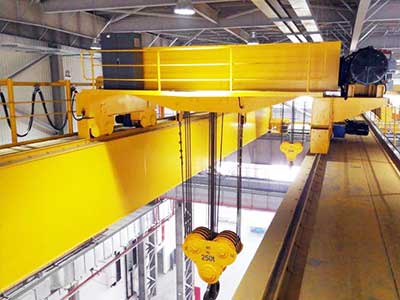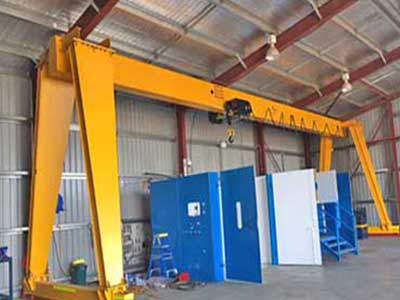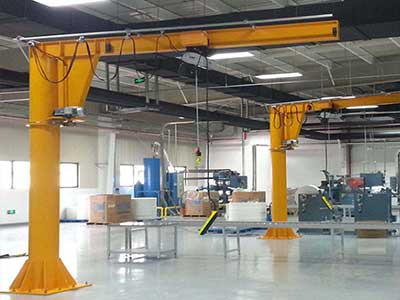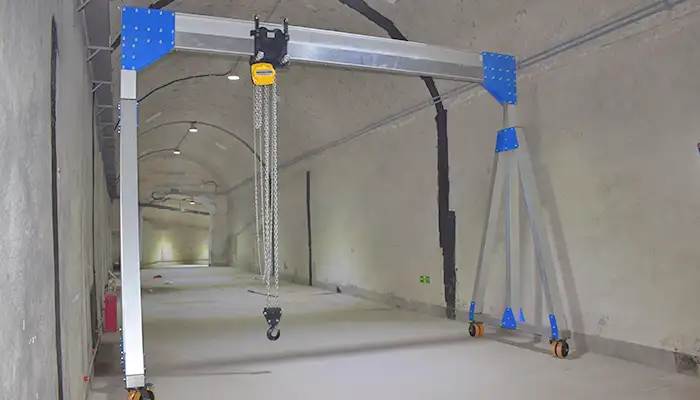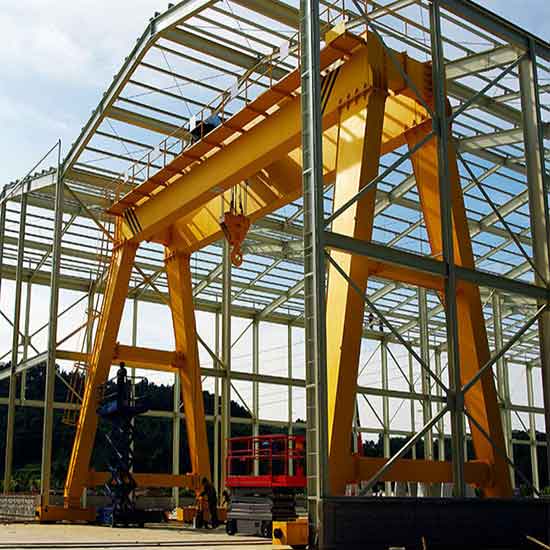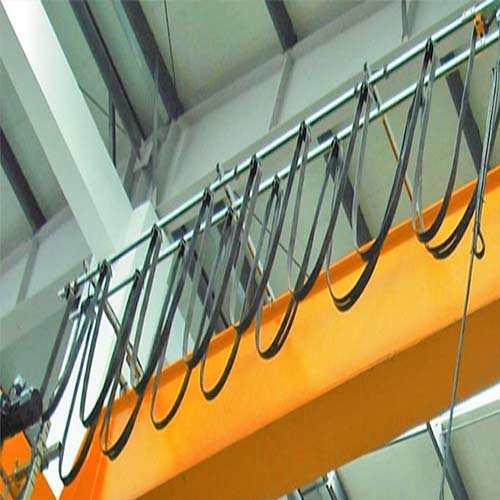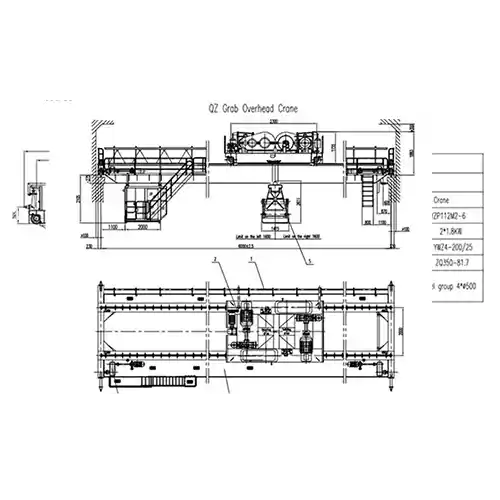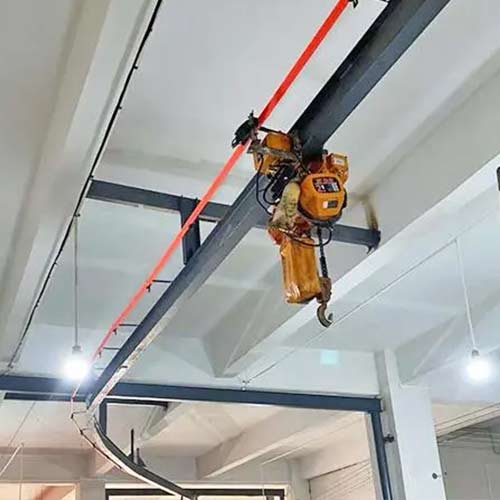Electric Jib Crane & Electric Jib Crane Hoist 2 Ton, 5 Ton 10 Ton
Electric jib crane for sale good price. Custom electric jib crane with hoist ie. wall jib crane & floor jib crane 1 Ton, 2 Ton, 3 Ton, 5 Ton 10 ton, 16 ton.
| Crane type | Electric jib crane |
| Crane capacity | 500kg -16 ton |
| Lifting Height | As your request |
| Crane span | As customer requirement |
Category: Overhead Crane for Your Use
Your Trusted Overhead Travelling Crane Manufacturer & Supplier
Electric Jib Crane & Electric Jib Crane Hoist 2 Ton, 5 Ton 10 Ton
Electric jib crane for sale good price. Custom electric jib crane with hoist ie. wall jib crane & floor jib crane 1 Ton, 2 Ton, 3 Ton, 5 Ton 10 ton, 16 ton.
Overvuew of Electric Jib Cranes: Enhancing Efficiency and Safety in Material Handling
In the field of industry and manufacturing, efficient material handling is a cornerstone of productivity and safety. One indispensable tool that has revolutionized the way heavy loads are moved, lifted, and positioned is the electric jib crane. This dynamic piece of equipment has found its place in various industries, offering a combination of precision, power, and versatility that simplifies complex material handling tasks. In this blog, we'll delve into the world of electric jib cranes, exploring their definition, applications, and the pivotal role they play in shaping today's industrial landscape.
Definition of Electric Jib Cranes
At its core, an electric jib crane is a specialized material handling device designed to effortlessly lift, transport, and place heavy loads within confined workspaces. What sets it apart are its unique features: a vertical mast, a horizontal boom, and an electric motor that powers its operation. This combination of components grants the electric jib crane exceptional flexibility, enabling it to reach challenging areas that traditional cranes might struggle to access. Picture a construction site where large beams need precise placement or a busy warehouse where swift material movement is essential – that's where the electric jib crane excels.
Applications and Industries
The applications of electric jib cranes span across a wide array of industries, each benefiting from their adaptability. In manufacturing, they facilitate the seamless movement of materials along assembly lines, streamlining production processes. On construction sites, these cranes effortlessly lift heavy loads to towering heights, aiding in the creation of awe-inspiring structures. Warehouses and logistics centers utilize them to expedite loading and unloading operations, ensuring timely order fulfillment. Even in the realm of workshops and maintenance facilities, electric jib cranes offer precision when maneuvering heavy machinery during repairs. Their capabilities are as diverse as the industries they serve.
Types of Electric Jib Cranes
Electric jib cranes exhibit a range of types, each meticulously designed to address specific operational demands and spatial considerations. Let's delve into the diverse realm of electric jib cranes and their distinctive characteristics:
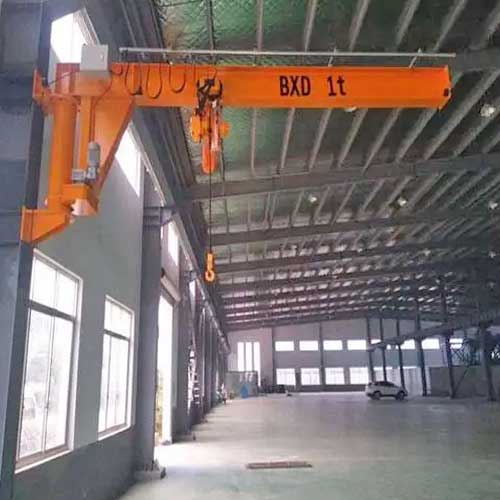
Wall-mounted Jib Cranes - Wall electric jib crane
Wall-mounted jib cranes present ingenious solutions that maximize both vertical and horizontal spaces. Securely affixed to walls, these cranes offer a remarkable approach to handling heavy loads within constrained work areas. Operating on a horizontal pivot, their mechanics enable rotation, granting a 180-degree range. This pivotal motion guarantees access to various workspaces without obstructing concurrent operations. Wall-mounted jib cranes excel in confined spaces, workstations, and scenarios where optimizing floor space is paramount.
- Description: Wall-mounted jib cranes are affixed to walls, providing space-efficient material handling solutions.
- Working Mechanism: They rotate horizontally on a pivot, delivering a 180-degree or 270 -degree rotation.
- Applications: Well-suited for confined spaces, workstations, and endeavors aimed at maximizing floor space.
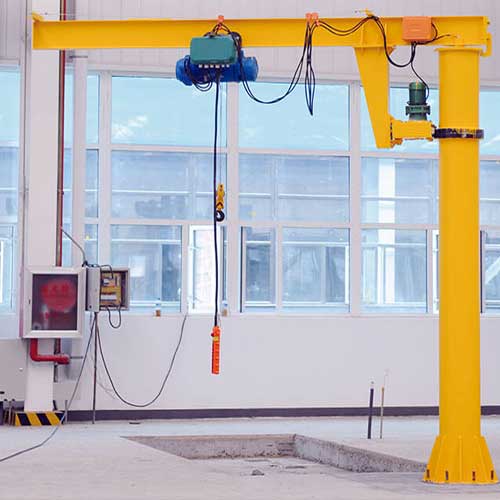
Freestanding Jib Cranes - Floor electric jib crane
Unlike their wall-mounted counterparts, freestanding jib cranes stand independently due to their self-supporting structures. These versatile cranes negate the need for wall attachments, rendering them fitting for open areas, outdoor settings, and sites where appropriate walls are absent. The combination of a robust vertical mast and a sturdy base facilitates an extensive range of rotation and diverse load capacity options. Freestanding jib cranes blend flexibility with stability, making them an optimal choice for scenarios that prioritize spatial flexibility.
- Description: Freestanding jib cranes have self-supporting structures and don't need wall support.
- Working Mechanism: Sturdy vertical mast and base allow for a wide range of rotation and load capacity options.
- Applications: Ideal for open areas, outdoor use, and locations without suitable walls.

Articulating (Knuckle) Jib Cranes
Articulating jib cranes epitomize flexibility. Equipped with distinctive two-part arms featuring a knuckle joint, they offer unparalleled maneuverability and exact load positioning. This exceptional joint empowers the crane to navigate around obstacles and access confined spaces without compromising stability. Articulating jib cranes excel in workshops, machining operations, and tasks requiring meticulous control over load placement. They prove invaluable when navigating intricate and complex work setups.
- Description: Articulating jib cranes have two-part arms with a knuckle joint, enabling flexibility and precise load positioning.
- Working Mechanism: The two-arm segments reach around obstacles and into confined spaces while maintaining stability.
- Applications: Useful in workshops, machining operations, and tasks requiring precise load control.
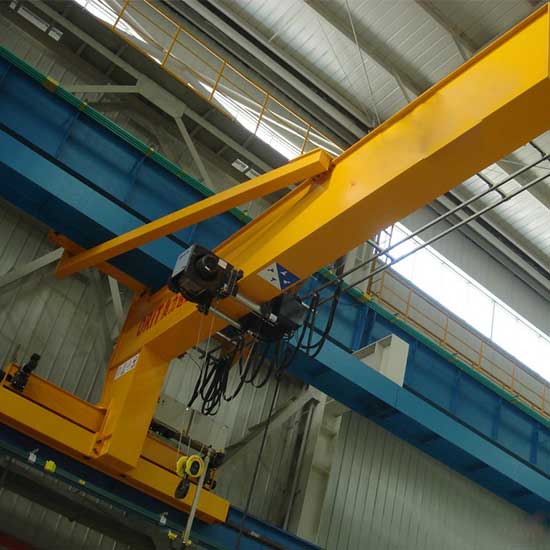
Wall-traveling Jib Cranes
Wall-traveling jib cranes introduce the advantages of horizontal mobility. Utilizing tracks attached to walls, these cranes extend their reach, making them a practical selection for scenarios that entail repetitive material handling along fixed paths. Their capability to cover multiple workstations or assembly lines positions them perfectly for streamlining material flow and expediting operations.
- Description: Wall-traveling jib cranes move horizontally on tracks attached to walls.
- Working Mechanism: Extendable reach across a wider area, covering multiple workstations or assembly lines.
- Applications: Suited for repetitive material handling along a fixed path, optimizing material flow.
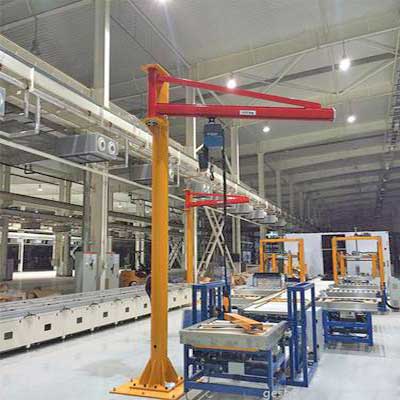
Mast-type Jib Cranes - Electric jib hoist crane
When heavy lifting becomes the priority, mast-type jib cranes rise to the occasion. Featuring fixed vertical masts, these cranes demonstrate the capacity to handle substantial loads and offer heightened lifting heights. While their rotation capabilities may have constraints, they compensate with remarkable lifting prowess. Mast-type jib cranes thrive in heavy-duty industries, construction sites, and locations necessitating elevated load lifting.
- Description: Mast-type jib cranes have fixed vertical masts, handling heavier loads and providing higher lifting heights.
- Working Mechanism: Usually offer limited rotation but compensate with increased lifting capabilities.
- Applications: Used in heavy-duty industries, construction sites, and areas requiring taller load lifting.
Components and Working Mechanism
Vertical mast or pillar
- Description: The vertical mast or pillar is the main vertical support structure of the electric jib crane.
- Function: It provides stability and strength to the crane, allowing it to bear the weight of the load.
- Material: Usually made from high-strength steel to withstand heavy loads and ensure durability.
Horizontal boom or arm
- Description: The horizontal boom or arm extends horizontally from the top of the vertical mast.
- Function: It holds the hoist and allows the movement of the load in and out of the working area.
- Material: Typically constructed from steel or aluminum, balancing strength and weight.
Electric motor and power supply
- Description: The electric jib crane is equipped with an electric motor for powering the lifting and rotation mechanisms.
- Function: The electric motor provides the necessary power to lift heavy loads smoothly and move the arm horizontally.
- Power Supply: Connected to an electrical power source, often using a cable reel or festoon system for mobility.
Rotation mechanism
- Description: The rotation mechanism allows the horizontal boom to rotate horizontally.
- Function: It enables the crane to move the load in a circular motion, covering a specific area within its radius.
- Types: Depending on the crane type, it can have a manual rotation system or be powered by an electric motor.
Lifting mechanism
- Description: The lifting mechanism is responsible for raising and lowering the load.
- Function: It ensures controlled lifting and lowering operations to position the load accurately.
- Components: Includes a hoist, wire rope or chain, and a hook or lifting attachment.
Control systems and safety features
- Description: Electric jib cranes are equipped with control systems and safety features for safe operation.
- Function: Control systems allow the operator to control the crane's movements and functions, while safety features protect against accidents and overloading.
- Safety Features: Examples include limit switches to prevent over-rotation, overload protection, emergency stop buttons, and warning alarms.
Understanding the components and working mechanism of an electric jib crane is essential for ensuring safe and efficient operation during material handling tasks. Each component plays a crucial role in the overall functionality and performance of the crane.
Importance in Material Handling
The efficiency of material handling is a linchpin for the smooth operation of industries. Electric jib cranes play a pivotal role by not only increasing productivity but also elevating safety standards. In environments where heavy loads are commonplace, the risk of workplace injuries can be significant. Electric jib cranes provide a compelling solution, reducing the need for manual labor and minimizing the potential for accidents. Their precision in load control ensures that materials are positioned with accuracy, avoiding mishaps that could lead to damage or injury.
The versatility and maneuverability of electric jib cranes make them indispensable tools for optimizing workflow and space utilization. They thrive in environments where space is at a premium, offering a nimble alternative to larger cranes that might be impractical in constrained areas. This ability to adapt to diverse settings and tasks cements their importance as essential players in the modern material handling landscape.
In the subsequent parts of this blog series, we will explore the various types of electric jib cranes, delve into their components and working mechanisms, discuss safety guidelines, and delve into real-world case studies showcasing their impact across industries.
Advantages of Electric Jib Cranes
Improved efficiency and productivity
- Swift Material Handling: Electric jib cranes enable quick and efficient lifting, moving, and positioning of loads, reducing downtime and improving workflow.
- Easy Load Access: Their ability to rotate and extend into specific areas allows for easy access to materials, optimizing material flow.
Precise control and positioning of loads
- Accurate Load Placement: Electric jib cranes offer precise control over load movements, ensuring accurate positioning without manual effort.
- Controlled Speed: The electric motor allows for smooth and controlled lifting and lowering, preventing sudden movements or jerks.
Reduction in manual labor and operator fatigue
- Reduced Physical Strain: Electric jib cranes handle the heavy lifting, reducing the need for manual labor and minimizing the risk of injuries.
- Operator Comfort: Electric-powered controls make it easier for operators to manage loads, reducing operator fatigue and increasing productivity.
Enhanced safety features
- Overload Protection: Built-in overload protection systems prevent the crane from lifting loads beyond its capacity, avoiding potential accidents.
- Limit Switches: Limit switches control the crane's range of motion, preventing collisions with obstacles and ensuring safe operation.
Versatility in handling various load capacities and sizes
- Adaptable Load Capacity: Electric jib cranes come in various load capacities, making them suitable for handling light to heavy loads.
- Different Attachments: The ability to use different lifting attachments allows these cranes to handle various load shapes and sizes.
Space Optimization:
Electric jib cranes can be installed in compact spaces, maximizing floor utilization and leaving more room for other operations.
Cost-Effective:
Electric jib cranes offer cost savings over time by reducing labor expenses, increasing productivity, and minimizing material damage.
H. Ease of Installation: Compared to larger cranes, electric jib cranes are relatively easier and quicker to install, saving time and installation costs.
Electric jib cranes are valuable assets in material handling operations, providing multiple advantages that lead to increased efficiency, safety, and cost-effectiveness. Their flexibility and adaptability make them an excellent choice for a wide range of industries and applications.
Selection Considerations of Electric Jib Cranes
Load capacity and working radius
- Determine Load Requirements: Assess the maximum weight of the loads to be lifted and moved by the electric jib crane.
- Consider Working Radius: Evaluate the required horizontal reach of the crane to access all work areas effectively.
Types of materials to be handled
- Material Characteristics: Understand the size, shape, and weight distribution of the materials to ensure the crane's suitability for safe handling.
- Material Sensitivity: Consider if the materials require special handling to avoid damage or ensure safety.
Environmental factors (indoor/outdoor use)
- Indoor vs. Outdoor Use: Determine whether the electric jib crane will be used indoors, outdoors, or in both environments.
- Weather Resistance: If used outdoors, choose a crane with appropriate protection against weather elements such as rain, dust, and humidity.
Space constraints and mounting options
- Available Space: Evaluate the available workspace to ensure the selected crane fits within the area without hindering other operations.
- Mounting Options: Choose the suitable mounting type (wall-mounted, freestanding, etc.) based on the space and structural support available.
Power supply requirements
- Electrical Capacity: Verify that the facility's electrical system can support the power requirements of the electric jib crane.
- Voltage and Phase: Check if the crane's power supply specifications match the available electrical voltage and phase.
Budget and cost considerations
- Initial Investment: Consider the total cost of purchasing and installing the electric jib crane, including any additional accessories or modifications.
- Operating Costs: Assess ongoing maintenance, electricity consumption, and any potential training expenses for crane operators.
- Long-term Value: Balance the initial cost with the crane's expected lifespan and benefits to determine its overall value.
Safety Compliance: Ensure the selected electric jib crane complies with relevant safety standards and regulations, reducing risks and liability.
Future Expansion: Consider potential future needs and expansion plans to choose a crane that can adapt to changing requirements.
Selecting the appropriate electric jib crane involves careful evaluation of these considerations to ensure the crane meets the specific needs of the operation, provides safety, and delivers the desired efficiency and productivity improvements.
Parameters Needed for Electric Jib Crane Quotation
In the following main parameters needed to confirm the electric jib crane design and get your specific jib crane price:
- Load Capacity: The maximum weight the crane needs to lift and handle.
- Working Radius: The distance the crane's arm must reach to access all work areas effectively.
- Material Type and Dimensions: The types of materials to be handled and their sizes/weights.
- 4. Crane Type: Whether it will be wall-mounted, freestanding, articulating, etc.
- 5. Mounting Option: The suitable mounting method based on available space and structural support.
- 6. Power Supply Requirements: Electrical capacity, voltage, and any specific power supply considerations.
- 7. Safety Features: Necessary safety features like overload protection, limit switches, and emergency stop buttons.
- 8. Control Systems: Preferred control method, such as push-button pendant, radio remote, or cabin-operated controls.
- 9. Compliance: Ensuring the crane design complies with relevant safety standards and regulations.
- 10. Budget and Timeline: The total cost of the customized crane, including installation, and the agreed-upon timeline for design, manufacturing, and delivery.
By confirming these parameters, you can ensure that the electric jib crane will be tailored to your specific needs and offer efficient and safe material handling solutions in your workspace.
Installation and Maintenance of Electric Jib Cranes
Site preparation and foundation requirements
- Clear Workspace: Ensure the installation area is free from obstructions and debris to facilitate smooth crane assembly and operation.
- Foundation Strength: Prepare a stable and level foundation capable of supporting the crane's weight and load capacity.
- Structural Assessment: Conduct a structural analysis to verify the building's integrity and ensure it can withstand the crane's forces.
Electrical connections and safety regulations
- Electrical Installation: Engage a certified electrician to connect and wire the crane's electrical components to the power supply.
- Safety Compliance: Ensure all electrical connections and installations adhere to relevant safety regulations and codes.
- Grounding: Implement proper grounding to prevent electrical hazards and ensure electrical safety.
Routine maintenance and inspections
- Scheduled Maintenance: Establish a routine maintenance schedule to ensure the crane's optimal performance and longevity.
- Lubrication: Regularly lubricate moving parts to minimize friction and wear, enhancing the crane's efficiency.
- Wear and Tear Inspection: Periodically inspect components, such as wire ropes, chains, and bearings, for signs of wear or damage.
- 4. Calibration: Verify and calibrate safety features, such as limit switches and overload protection, to maintain accurate operation.
Troubleshooting common issues
- Operator Training: Provide comprehensive training to crane operators to identify and address minor issues during operation.
- Operator Reporting: Encourage operators to report any irregularities or malfunctions promptly for timely resolution.
- Expert Consultation: Involve experienced crane technicians or manufacturer representatives for diagnosing and resolving complex issues.
- 4. Maintenance Logs: Keep detailed records of maintenance and inspection activities to track the crane's performance and history.
By following these installation and maintenance guidelines, you can ensure the safe and efficient operation of the electric jib crane while minimizing downtime and enhancing workplace safety. Regular inspections and proper care will help extend the crane's service life and optimize its performance.
Safety Guidelines
Operator training and certification
- Comprehensive Training: Ensure operators receive proper training on the safe operation of electric jib cranes, including crane controls, load handling, and emergency procedures.
- Certification: Require operators to obtain the necessary certifications and licenses to operate the crane legally and safely.
Overload protection and limit switches
- Overload Protection: Install overload protection devices to prevent the crane from lifting loads beyond its rated capacity, reducing the risk of accidents.
- Limit Switches: Implement limit switches to control the crane's range of motion and prevent collisions with obstacles, promoting safe operation.
Emergency stop buttons and safety interlocks
- Emergency Stop: Install easily accessible emergency stop buttons to immediately halt crane operations in case of any unsafe conditions or emergencies.
- Safety Interlocks: Implement safety interlocks to prevent crane movement in certain situations, such as when doors are open or when other safety parameters are not met.
Personal protective equipment (PPE) requirements
- Mandatory PPE: Enforce the use of appropriate personal protective equipment, such as hard hats, safety glasses, gloves, and high-visibility clothing, for all personnel working near the crane.
- Operator Gear: Provide operators with specific PPE, such as safety harnesses and fall protection equipment, for increased safety while operating the crane at heights.
Comparison with Other Types of Electric Cranes
Electric jib cranes vs. overhead cranes
- Design and Structure: Electric jib cranes are typically smaller and have a more compact design, suitable for limited workspaces, while overhead cranes are larger and span longer distances.
- Movement: Electric jib cranes offer rotation within a limited radius, while overhead cranes can move along multiple axes on rails.
- Cost and Installation: Electric jib cranes are generally more cost-effective and easier to install compared to overhead cranes, which may require extensive structural modifications.
Electric jib cranes vs. gantry cranes
- Support Structure: Electric jib cranes are usually wall-mounted or freestanding with a vertical mast, while gantry cranes have supporting legs that move on wheels or tracks.
- Mobility: Gantry cranes offer higher mobility and can cover larger areas, while electric jib cranes are better suited for localized lifting tasks.
- Versatility: Electric jib cranes provide more flexibility in rotating and reaching specific spots, making them suitable for precise positioning.
Electric jib cranes vs. mobile cranes
- Portability: Mobile cranes are fully self-contained and transportable, whereas electric jib cranes are usually fixed or require disassembly and reassembly for relocation.
- Load Capacity: Mobile cranes generally have higher load capacities, making them suitable for heavy lifting tasks, while electric jib cranes have more limited capacities but offer better maneuverability in restricted spaces.
- Application: Electric jib cranes are commonly used in indoor and workshop environments, while mobile cranes are commonly used in construction and outdoor settings.
Comparing electric jib cranes with other types of cranes can help determine the most suitable option based on specific operational needs, space constraints, and lifting requirements.
Case Studies and Applications
Manufacturing industry
- Application: Electric jib cranes are commonly used in manufacturing facilities for various tasks, such as moving raw materials, positioning workpieces during assembly, and transferring finished products to packaging or storage areas.
- Benefits: The precise control and positioning offered by electric jib cranes enhance workflow efficiency and reduce the risk of damage to delicate or expensive materials. They also optimize floor space utilization, crucial in manufacturing environments with limited space.
Construction sites
- Application: Electric jib cranes find application in construction sites for lifting and transporting materials such as steel beams, concrete blocks, and construction equipment to different levels of buildings or across construction areas.
- Benefits: Their versatility allows electric jib cranes to access and lift heavy materials in congested construction sites where larger cranes may be impractical or not feasible. They enable faster and safer material handling, contributing to increased productivity.
Warehouses and logistics centers
- Application: Electric jib cranes are employed in warehouses and logistics centers for efficiently loading and unloading pallets, containers, and heavy packages from trucks or conveyors.
- Benefits: The maneuverability of electric jib cranes enables them to reach deep into storage racks or confined areas, optimizing material flow and reducing manual labor. They contribute to smooth logistics operations and swift order fulfillment.
Workshops and maintenance facilities
- Application: Electric jib cranes are extensively used in workshops and maintenance facilities for lifting and positioning heavy machinery, tools, and parts during repair or maintenance tasks.
- Benefits: Their precise control and positioning make them ideal for delicate maintenance operations. The ability to rotate and extend into tight spaces allows mechanics to access equipment from different angles, streamlining repair processes.
These case studies demonstrate the adaptability and versatility of electric jib cranes across various industries and applications. Their ability to provide efficient and safe material handling solutions makes them a valuable asset in enhancing productivity and streamlining operations in diverse work environments. If you want to know more about jib crane projects, please contact us by leaving a message down below or by contact us by WhatsApp : + 86 151 3871 1597.
FAQs on electric jib cranes
Here are some frequently asked questions about electric jib cranes along with their respective answers:
Q What is an electric jib crane?
- A1: An electric jib crane is a type of material handling equipment designed for lifting, moving, and positioning heavy loads within a limited workspace. It consists of a vertical mast, a horizontal boom or arm, and an electric motor for operation.
Q What are the key advantages of using electric jib cranes?
- A2: Electric jib cranes offer improved efficiency, precise load control, reduced manual labor, enhanced safety features, and adaptability to various load capacities and sizes. They are especially valuable in confined spaces and areas with limited access.
Q What industries can benefit from electric jib cranes?
- A3: Electric jib cranes find applications in diverse industries, including manufacturing, construction, warehouses, workshops, maintenance facilities, and more, due to their versatility in material handling tasks.
Q How do I choose the right type of electric jib crane for my needs?
- A4: Consider factors such as load capacity, working radius, available space, mounting options, and environmental conditions. Consult with experts or crane manufacturers to ensure you select the most suitable crane for your specific requirements.
Q Can electric jib cranes be installed outdoors?
- A5: Yes, certain types of electric jib cranes, like freestanding or wall-traveling cranes, can be installed outdoors. However, factors such as weather protection, environmental conditions, and proper maintenance need to be considered.
Q What safety features do electric jib cranes have?
- A6: Electric jib cranes are equipped with various safety features, including overload protection, limit switches to prevent collisions, emergency stop buttons, and safety interlocks. These features help ensure safe operation and prevent accidents.
Q How often should I perform maintenance on an electric jib crane?
- A7: Regular maintenance should be performed according to the manufacturer's recommendations. Routine inspections, lubrication of moving parts, calibration of safety features, and addressing wear and tear are essential to ensure the crane's optimal performance and longevity.
Q Are operator training and certifications required to operate electric jib cranes?
- A8: Yes, operators should undergo proper training and obtain necessary certifications to operate electric jib cranes safely and effectively. Proper training ensures the operator understands the equipment's controls, safety procedures, and best practices.
Q Can I retrofit an existing jib crane with electric components?
- A9: In some cases, it is possible to retrofit an existing manual jib crane with electric components to make it electrically powered. However, feasibility depends on the crane's design and structural integrity. Consultation with experts is recommended.
Q What are the cost considerations when investing in an electric jib crane?
- A10: The cost of an electric jib crane includes the crane itself, installation, electrical connections, and potential modifications to the workspace. Consider the long-term benefits in terms of increased efficiency, reduced labor costs, and enhanced safety when evaluating the investment.
These frequently asked questions and their answers should provide you with a clearer understanding of electric jib cranes and their applications. If you have any specific queries or require further information, don't hesitate to reach out to crane manufacturers or industry experts.
Conclusion
The benefits and versatility of electric jib cranes
- - Electric jib cranes offer several advantages, including improved efficiency and productivity through swift material handling and easy load access.
- - Their precise control and positioning capabilities ensure accurate placement of loads without manual effort.
- - By reducing manual labor and operator fatigue, electric jib cranes create a safer working environment and increase operator comfort.
- - Enhanced safety features, such as overload protection and emergency stop buttons, contribute to accident prevention and risk reduction.
- - The versatility of electric jib cranes allows them to handle various load capacities and sizes, making them adaptable to different applications.
Importance of selecting the right crane for specific applications
- - Choosing the appropriate electric jib crane for a specific task or industry is crucial to optimize performance and safety.
- - Understanding the load capacity, working radius, and material handling requirements ensures that the crane meets operational needs efficiently.
- - Considering the environment, available space, and mounting options allows for seamless integration and minimal disruption in the workspace.
- - Addressing power supply requirements and safety regulations ensures the crane's compliance and seamless integration into existing systems.
Potential for increased efficiency and safety in material handling processes
- - Electric jib cranes streamline material handling tasks, reducing downtime and enhancing workflow efficiency.
- - Their precise and controlled movements improve load positioning, reducing the risk of accidents and material damage.
- - By minimizing manual labor and implementing safety features, electric jib cranes contribute to a safer and more productive work environment.
- - Their adaptability and versatility make them valuable tools across various industries, enhancing overall efficiency in material handling processes.
In conclusion, electric jib cranes offer numerous benefits, including improved efficiency, precise load control, reduced manual labor, and enhanced safety. By selecting the right crane for specific applications and adhering to safety guidelines, businesses can unlock the potential for increased efficiency and safety in their material handling operations. The versatility of electric jib cranes makes them a valuable investment for diverse industries seeking optimized workflow and increased productivity.
Main Projects
Related Products
Supplied three grab bucket crane kits to Indonesia, enhancing garbage handling efficiency with high load capacity and reliable performance.
Free consultation to Confirm Parameters & Specifications and Get
Latest Crane Price & Crane Rate.
- Types of overhead cranes : _______?
- Optional: Overhead travelling crane, goliath gantry crane,Slewing jib crane, Single girder or double girder crane,small portable crane or kbk crane, etc.
- Capacity of overhead crane: _______?
- Optional: 0.25ton, 0.5 ton, 1 ton, 2 ton, 3ton, 5 ton, 10 ton,15ton, 20ton, 25 ton, 30ton,35ton, up to 550ton, etc.
- Crane span & lifting height : _______?
- Crane travelling length : _____?
- Control of overhead crane:_______?
- Optional: pendant/ remote/cabin control
- Voltage supply of overhead crane:_____?
- Eg,: 380V50/60HZ,3Phase or others,etc.
- Application/usage of crane:_______?
- Eg,: Steel mill, ,injection mold, cement,stone, concrete,granite, general manufacturing, etc.
Just leave a message via the contact form and our hoist and crane engineer will contact you with in 24working hours.
Get In Touch
